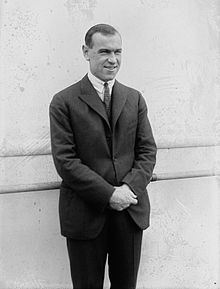Gerald Patterson
 |
|
| Country (sports) |
|
|---|---|
| Born |
17 December 1895 Preston, Australia |
| Died | 13 June 1967 (aged 71) Melbourne, Australia |
| Turned pro | 1914 (amateur tour) |
| Retired | 1928 |
| Plays | Right-handed (one-handed backhand) |
| Int. Tennis HoF | 1989 (member page) |
| Singles | |
| Highest ranking | No. 1 (1919, A. Wallis Myers) |
| Grand Slam Singles results | |
| Australian Open | W (1927) |
| French Open | 4R (1928) |
| Wimbledon | W (1919, 1922) |
| US Open | SF (1922, 1924) |
| Doubles | |
| Grand Slam Doubles results | |
| Australian Open | W (1914, 1922, 1925, 1926, 1927) |
| Wimbledon | F (1922, 1928) |
| US Open | W (1919) |
| Mixed doubles | |
| Grand Slam Mixed Doubles results | |
| Wimbledon | W (1920) |
Gerald Leighton Patterson MC (17 December 1895 – 13 June 1967) was an Australian tennis player.
Patterson was active in the decade following World War I. During his career he won three Grand Slam tournaments in the singles event as well as six titles in the doubles competition. He was born in Melbourne, educated at Scotch College and Trinity Grammar School and died in Melbourne on 13 June 1967. He was the co-World No. 1 player for 1919 along with Bill Johnston.
Tall and well-built, Gerald Patterson played a strong serve-and-volley game that won him three major singles. Patterson was known as the "Human Catapult" for his powerful serve that many of the top players had trouble returning. He also enjoyed great success representing Australia in Davis Cup and amassed a 32–14 win–loss record (singles 21–10, doubles 11–4) and was part of the winning team in 1919. Patterson played Davis Cup in 1920, 1922, 1924, 1925, 1928 and finally as captain in 1946. He was a player ahead of his time, playing with a steel racquet strung with wire in 1925.
He was inducted into the Sport Australia Home of Fame in December 1986. This was followed by induction into the International Tennis Hall of Fame in 1989 and the Australian Tennis Hall of Fame in August 1997.
Patterson was the nephew of Australian opera singer Dame Nellie Melba and father of racing driver Bill Patterson. Patterson was awarded the Military Cross for bravery as an officer in Royal Field Artillery in 1917 at Messines.
...
Wikipedia
